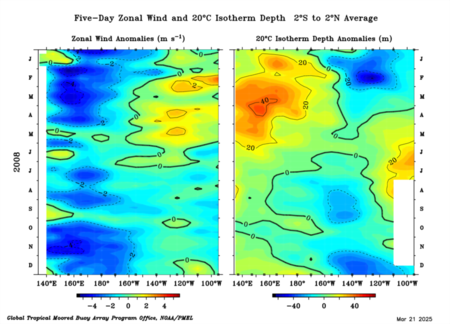Ntxw wrote:LarryWx wrote:26FEB2025 27.5 1.1 27.0 0.3 26.7-0.2 27.5-0.6
05MAR2025 28.1 1.6 27.4 0.5 27.0 0.0 27.8-0.3
So, the latest week being reported (last calendar week) shows all regions warmed with Nino 3.4 up to 0.0 and Nino 1+2 up to a whopping +1.6. But keep in mind that these aren’t taking into account the relatively warm surrounding tropical/global waters like RONI does. So, one may want to subtract ~0.5 to 0.6 to get a better picture of the situation. Regardless, the trends have been clearly warmer and Nino 1+2, itself, would still be in moderate Nino territory and Nino 3 would be up to neutral.
https://www.cpc.ncep.noaa.gov/data/indi ... st9120.for
Question for you Larry, if the RONI is the superior index, how would you grade this past winter noting was showing a better La Nina than ONI based off the PAC teleconnections? My initial guess is that the +PNA and North Pacific Aleutian trough gave some questions as to how reliable it is. Should we not have seen a more robust -PNA/Aleutian ridge combo per RONI?
https://i.imgur.com/gIw6C2N.gif
Great Q!
1) Indeed, in a typical solid La Niña (though not in nearly all of them of course), I agree that we would have seen a somewhat dominant -PNA/Aleutian ridge.
2) Instead we had the opposite. The seasonal models’ forecasts made several months out were largely clueless about this.
3) Interestingly, the seasonal models were also clueless about the El Niño of 2023-4 with their understandable forecast for a typical of El Niño dominant +PNA/Aleutian trough. What they forecasted for 2023-4 consistent with the actual El Niño actually occurred during the 2024-5 negative neutral to unofficial La Niña (if you go by RONI)!
4) So, the last two winters have been bizarre in relation to typical ENSO.
5) This just goes to show that ENSO, itself, is not always the dominant seasonal factor.
6) Sort of related, I’m not concluding from 2024-5, alone, that RONI is inferior to ONI when it comes to which should be used more to try to make a seasonal forecast whether winter or tropical. There are always exceptions. Also, keep in mind that even cold neutral (which is official per ONI for 2024-5) doesn’t itself favor a dominant +PNA/Aleutian trough.
7) Thus I expect to continue emphasizing the importance of being aware of RONI but also keeping in mind that ENSO isn’t always the main factor. To me the concept makes a lot of sense.
Edit: On average as I posted about several times and was shown by another poster (“US Tropics”??) in graphical form, ENSO fall/winters peaking as weak La Niña had been the most dangerous ENSO as regards the hurricane season (worse than fall/winter peaking as either strong La Nina or cold neutral) for the corridor from the Lesser Antilles through Puerto Rico, the Bahamas, FL, and the SE US coast. Well, it ended up a terrible season in those areas overall. That, alone doesn't of course prove RONI is a better indicator but it certainly was more in line than ONI in that regard.














